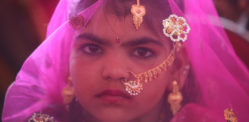"They don't have the psychological resources to cope"
Despite concerted efforts and legislative measures, child marriages continue to persist as a critical challenge in India.
India, while aspiring to eliminate this practice by 2030, remains home to the largest number of child brides globally.
Shockingly, one in three of the world’s child brides resides within Indian borders.
The prevalence of child marriage remains alarmingly high, with nearly one in four young women in India being married or in union before their 18th birthday.
The situation is further exacerbated by regional disparities, with over half of the girls marrying in childhood hailing from just five states: Uttar Pradesh, Bihar, West Bengal, Maharashtra and Madhya Pradesh.
This is a similar situation to child grooms who are still seen across the country.
However, the amount of boys in this situation has decreased, as per a 2016 report by UNICEF.
Despite notable progress over the years, the rate of decline falls short of meeting the targets outlined in the government’s goals.
Drivers of Child Marriage
As per the Harvard T.H. Chan School of Public Health:
“By 2021, the researchers counted more than 13.4 million women and more than 1.4 million men ages 20-24 who were married as children.
“The results showed that one in five girls and nearly one in six boys are still married below India’s legal age of marriage.”
Many reasons contribute to child marriages in India which are broken up into different areas:
Detrimental Practices
In patriarchal social structures, the belief persists that married women and girls are essentially the property of their husbands’ families, and women are often viewed as a financial burden.
Girls are expected to conform to societal norms of adaptability, obedience, diligence, and skills suitable for marriage.
Additionally, customary laws pose significant obstacles to eradicating child marriage in India.
Regulation of Female Sexuality
Until a daughter is married, her innocence is regarded as a reflection of her father’s honour, thereby pressuring men to arrange early marriages for their daughters.
Particularly within certain castes, there exists immense social pressure to marry off girls upon reaching puberty.
Some girls are pledged to marriage even before birth as a means to “secure” their future.
Upon attaining puberty, ceremonies such as gauna, or “send-off,” are conducted, and the girls are sent to their husband’s homes to initiate married life.
Socioeconomic Factors
Child marriage is more prevalent among economically disadvantaged households, with many families opting for early marriages to alleviate perceived money problems.
Young girls are often married off early as they are seen to require lesser dowry.
Likewise, child grooms are pressured into marrying early so their parents can receive gifts and money to save for later in life.
Education
Women lacking formal education are six times more likely to be married off compared to those with at least 10 years of schooling.
In many families, girls are considered “property”, implying that their potential contribution is directed towards their marital family.
Consequently, investing in girls’ education is often deprioritised.
This is particularly seen in rural areas where limited access and poor quality of academia block education beyond middle school.
Furthermore, due to the scarcity of employment opportunities, the value of education is diminished, particularly in villages.
Household Duties
Early marriage is often justified by the belief that girls are most “productive” during puberty and can efficiently manage household chores and childcare.
The labour of young brides is integral to sustaining certain rural economies.
Gender-Based Violence
Some girls are married off due to concerns over their safety and the prevalent fear of violence against women and girls in public spaces, with numerous cases reported daily.
However, child brides in India face a heightened risk of experiencing sexual and physical violence within their marital homes.
Child grooms can equally face such violence in the form of judgement or psychological violence if they don’t adhere to certain gender roles like being the “breadwinner” or providing for their family.
Inadequate Legal Enforcement
Persistent legal loopholes contribute to the impunity surrounding child marriage, with limited awareness of existing laws and barriers hindering access to justice.
COVID-19
The COVID-19 pandemic has disproportionately affected the most vulnerable households, exacerbating the vulnerability of children.
Economic hardships resulting from the pandemic have pushed already vulnerable families further into poverty and marginalisation.
School closures have disrupted the education of 247 million children enrolled in primary and secondary schools, as well as 28 million children enrolled in preschool in Anganwadi centres.
Impact and Consequences
The consequences of child marriage are far-reaching and profound.
Child marriages deprive children, especially girls, of their fundamental rights to education, health, and protection.
Moreover, child brides are at a heightened risk of experiencing domestic violence, early pregnancy, and adverse health outcomes.
Additionally, child marriages detrimentally impact the Indian economy.
Children married at a young age often lack the necessary skills, knowledge, and employment opportunities to lift their families out of poverty and contribute to the advancement of their country.
Early marriage particularly affects girls, leading them to have children earlier and in greater numbers throughout their lifetime, thus increasing the economic burden on their households.
The insufficient investment in ending child marriage in many countries may be attributed, at least in part, to the lack of a compelling economic argument against the practice.
Due to societal norms that devalue girls relative to boys, girls are often viewed as having no alternative but to marry early.
They are expected to fulfil domestic duties and assume household responsibilities in preparation for marriage.
Research indicates that key factors in empowering adolescent girls include:
- Delaying marriage until after the legal age
- Enhancing their health and nutrition
- Facilitating their transition to secondary education
- Equipping them with marketable skills
By doing so, girls can realise their economic potential and transition into healthy and productive adults.
Likewise, the impact on child grooms is often overlooked.
In 2019, UNICEF did its first report on child grooms and an estimated 115 million boys/men around the world were married as children.
UNICEF’s Henrietta Fore revealed:
“Child grooms are forced to take on adult responsibilities for which they may not be ready.
“Early marriage brings early fatherhood and with it added pressure to provide for a family, cutting short education and job opportunities.”
The technical director and senior clinical psychologist for the Centre of Mental Health and Counselling in Nepal, Pashupati Mahat, added to this:
“Young men force themselves to be adults, but they don’t have the psychological resources to cope with all the demands.
“There is more isolation, alienation and a lot of psychological pain within themselves.”
“They are not skilled enough to provide the good affectionate, emotional support [and] use a punitive parenting style.
“They don’t want to face the difficult emotions of the child because they never got the opportunity to deal with their emotional difficulties when they were quite young.”
He added that boys compelled into child marriages experience elevated levels of depression, loneliness, and suicide compared to girls in similar circumstances.
Governmental and International Commitments
India has made commendable commitments both at the national and international levels to address child marriages.
These commitments align with global objectives such as the Sustainable Development Goals and international conventions like the Convention on the Rights of the Child.
However, challenges persist in translating these commitments into tangible outcomes. There are limited updates on progress.
State-level decentralisation efforts must be more cohesive for substantial change.
The legal framework governing child marriage in India, notably the Prohibition of Child Marriage Act of 2006, establishes 18 as the minimum legal age of marriage for girls.
However, enforcing this is worrying, particularly concerning personal laws and customary practices.
During the Nairobi Summit on ICPD25 in 2019, India pledged to confront all types of violence against women and girls, yet notably omitted any reference to child marriage.
Previous policy interventions have focused on a range of measures including incentives, empowerment programs, and awareness-raising campaigns.
The 2020 Global Programme Report
Whilst one can argue about the lack of measurable success of India’s efforts to end child marriages, there are certain initiatives that have had a significant effect.
The 2020 annual report of the Global Programme to End Child Marriage highlighted several significant achievements:
- Three states (Assam, Jharkhand, and Rajasthan) implemented a training package on alternative education for out-of-school children, benefiting around 115,000 adolescent girls from marginalised communities
- Amidst the pandemic, 1.5 million adolescent girls received life-skills training to address child marriage
- Life-skills training focused on sexuality education engaged 3.6 million adolescent girls
- Five states were assisted in developing and costing action plans to combat child marriage
- During COVID-19, 10 million parents participated in dialogues on responsive parenting through online platforms and community networks, aiming to prevent child marriage and gender-based violence
- Approximately 3000 community leaders were mobilised and sensitised to prevent and respond to child marriage and gender-based violence
- Efforts in 12 states reached 9 million community members, promoting gender-equitable attitudes and offering alternatives to child marriage
- Maharashtra saw the development of eight films and information resources to sensitise village child protection committees
- This initiative led to the establishment of 44,000 trained village child protection committees focused on ending child marriage, preventing gender-based violence, and protecting children
- In Odisha, collaboration between village communities and district prohibition and social welfare officials resulted in the cancellation of over 800 child marriages.
- Similar efforts in Bihar, Uttar Pradesh, and Maharashtra led to the cancellation of 900, 898, and 629 marriages, respectively
While these initiatives have yielded some progress, addressing the root causes of child marriage demands more comprehensive and sustained efforts.
Child marriages remain a formidable obstacle to India’s progress and development, requiring urgent and concerted action from all stakeholders.
By addressing the root causes, strengthening legal frameworks, and promoting gender equality, India can pave the way towards a safer future.
As the nation strives to achieve its developmental goals, eliminating child marriage must remain a top priority.
































































